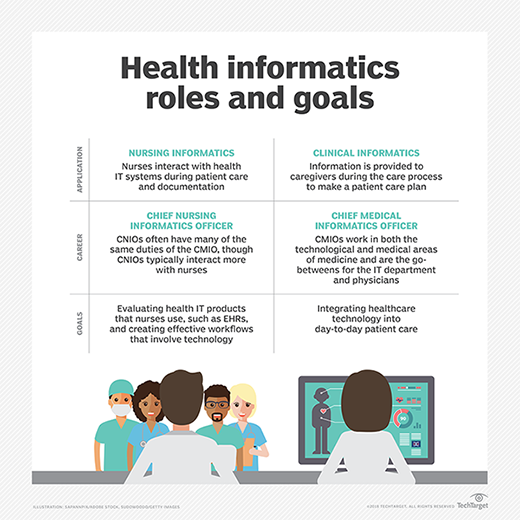What is health informatics?
Health informatics is the practice of applying insight gained from acquiring and analyzing health and biomedical data to help clinicians make better healthcare-related decisions and improve patient care.
Sometimes known as healthcare informatics, health informatics has grown with the expansion of electronic health records (EHRs), health information exchange (HIE) and health data analytics systems. The adoption of health data exchange standards, such as Health Level Seven International (HL7) and Fast Healthcare Interoperability Resources (FHIR), and clinical health terminology sets, like SNOMED CT, also advanced the science.
Importance and benefits of health informatics
Health informatics is an interprofessional field, combining the clinical expertise of healthcare professionals with information technology, computer science systems and tools. Its primary goal is to infuse health data with meaning to generate actionable insights that support scientific inquiry and facilitate clinical or medical problem-solving and decision-making.
The use of real-time clinical data and generation of meaningful insights also improves communication between healthcare professionals and patients, which can elevate patient care and outcomes. Timely, accurate health informatics also help to reduce medical errors and expand access to healthcare. In addition, informatics can provide real-time feedback that helps healthcare organizations improve operational efficiency and patient care, while reducing costs.
Health informatics, analytics and insights can also play a key role in the following:
- Shortening the duration of inpatient stays.
- Decreasing the likelihood of readmission.
- Reducing inpatient mortality rates.
Scope of health informatics
The scope of health informatics is broad, encompassing numerous subfields, each with its own focus area and specific goals. The main sub-fields are the following:
Clinical informatics
Clinical informatics is the application of IT to improve clinical research, care delivery and patient outcomes. Its main goal is to supply physicians, nurses, physical therapists, aides and other caregivers with information they can use to develop patient care plans.
Clinical informaticists straddle medical and informatics environments. They analyze data and medical images and develop user-friendly interfaces to health IT systems. These interfaces help clinicians retrieve, view and use health data more easily to inform their diagnoses, treatment planning, and decisions.
Nursing informatics
Nursing informatics encompasses nurses' interactions with health IT systems to improve care coordination, quality, and effectiveness. The field has become more important as most healthcare facilities have put their patient records online and entrusted their nursing teams to handle transition-of-care situations in their EHRs. The increasing popularity of telehealth has also sparked the growth of nursing informatics technologies and tools.
Nursing informatics specialists try to accurately document transitions of care, such as when a patient moves from an ambulatory setting to a hospital or from a hospital to a rehabilitation center. Insurance programs like Medicare as well as private insurance reimbursement programs often require this documentation.
Like clinical informatics, nursing informatics is an interdisciplinary field and requires collaboration between nurses and IT professionals. It's a growing field, and students can receive academic certificates and degrees.
Public health informatics
Public health informatics is the application of computer science, information and technology to public health administration, management, research, and education. It can also be used for disease surveillance, prevention, and preparedness.
Public health informatics professionals implement and manage health IT and databases to support public health initiatives, programs, and policies. They collect and analyze public health data, such as disease trends and emerging health threats, track disease outbreaks (epidemics and pandemics), and help government agencies and other stakeholders coordinate responses. They guide government and nonprofit health administrators in making data-driven decisions about public health policies and programs, such as chronic disease prevention.

Roles for health informatics professionals
Diverse roles are available for professionals specializing in health informatics:
- Chief medical information officer (CMIO).
- Chief nursing informatics officer (CNIO).
- Clinical information manager.
- Nurse informaticist.
- Clinical informaticist.
- Clinical analyst.
- Clinical data analyst.
- Health data analyst.
- Health informatics analyst.
- Health informatics specialist.
- Health informatics consultant.
- Medical records specialist.
- Biostatistician.
- EHR support analyst.
Besides these, industry-agnostic roles like IT consultant and project manager are also in demand within health informatics.
Some of the roles in health informatics are usually entry-level. Examples include clinical informaticist, clinical data analyst and health informatics analyst. Other positions like clinical information manager, CNIO and CMIO are leadership positions, with these individuals expected to guide implementation of technology solutions and initiatives to improve healthcare operations, ensure regulatory compliance, and enhance patient care and outcomes.
Health informatics professionals might work for hospitals, clinics, healthcare networks and doctors' offices. They might also work in long-term care facilities, medical or pharmaceutical research laboratories, and public health organizations and government agencies.
Other organizations that hire health informatics specialists include the following:
- Health/medical insurance companies.
- Medical billing firms.
- Medical oversight firms.
- Medical technology/systems vendors.
- Information security firms.
Responsibilities of health informatics professionals
One of the primary responsibilities of health informatics professionals, particularly those with more hands-on roles, is to collect, analyze and interpret health data to inform clinical practice, streamline workflows and support decision-making. In doing so, they help to improve patient care, safety and outcomes.
These specialists also digitize healthcare records and centralize digital information so it's easily available to healthcare teams. They also identify trends and generate reports to help organizations optimize clinical, diagnostic and other workflows, address inefficiencies, reduce costs, and increase profitability.
Senior-level health informatics professionals and managers are responsible for planning, implementing, maintaining, and managing the organization's information system and ensuring it's well-integrated with other systems. They might design and build databases, ensure regulatory compliance, and provide the training and support necessary to use the system.
Health informatics professionals are sometimes in charge of designing programs and systems that use AI, internet of medical things (IoMT), big data, predictive analytics and cloud computing to analyze patient data, create forecasts and generate actionable insights. A host of healthcare professionals can use these systems to do the following:
- Analyze medical images faster.
- Understand symptom patterns.
- Make more accurate diagnoses.
- Design tailored and more effective treatment plans.
- Enhance the efficacy of diagnostic tests.
- Create novel drugs.
- Drive new innovations for greater efficiency and efficacy, or lower costs.
Roles of CMIOs and CNIOs in health informatics
CMIOs span the medical and technological sides of medicine, bridging the gap between clinicians and technology. They are intermediaries between physicians and the IT department, translating clinical needs into IT solutions. In this way, they ensure that medical staff can use technologies and data effectively to inform their work and decisions, benefiting the organization and their patients.
CMIOs and their teams manage strategic planning, design, implementation, and integration of various technologies and associated tools into medical workflows. These technologies may include:
- EHR.
- AI and machine learning (ML).
- Big data.
- Data analytics and predictive analytics.
- Mobile health (mHealth).
- Telehealth.
- Robotics.
- Cloud computing.
- IoMT.
- Blockchain.
- Virtual reality (VR)/augmented reality (AR).
- Wearable devices.
- Three-dimensional bioprinting.
- Digital twins.
When implementing these systems, CMIOs make sure that each system aligns with the organization's clinical workflows, patient-related goals, data security goals and compliance requirements. They might also make data-driven decisions to identify relevant trends and opportunities to improve patient care and health outcomes.
Besides leading new technological initiatives, CMIOs might be responsible for change management. They might implement initiatives to replace older systems with newer technologies for medical staff to help them increase care delivery efficiency, improve patient safety and enhance patient satisfaction. Additionally, they might head a team that provides training and support to clinicians and their staff on the effective use of new IT systems and applications.
CMIOs are often licensed doctors (M.D.) and are required to have proven clinical practice experience as well as experience in medical informatics or health IT. In some organizations, the CMIO is also known as the director of health informatics, director of clinical informatics, or the director of medical informatics. Some organizations also require their CMIOs to be board-certified in their specialty, have a degree in health informatics, and some or all of the following:
- Demonstrable healthcare administration experience.
- Expertise in implementing and managing health IT systems and technologies (including EHR).
- Strong leadership skills.
- Strong communication and people management skills.
- Proficiency in data analytics tools and methodologies.
- Demonstrable familiarity with data interoperability standards and data privacy regulations (Health Insurance Portability and Accountability Act, Health Information Technology for Economic and Clinical Health Act, etc.).
A CNIO's duties can overlap with those of a CMIO. The CNIO role is typically more targeted at evaluating products and developing a workflow within which nursing teams can effectively use the technologies they depend on, such as the EHR system. CNIOs also play a role in providing education and training so nurses can leverage new informatics technologies and tools.

Education needed for health informatics careers
Many colleges and universities offer specialized bachelor's and master's degrees in health informatics. These degrees might have titles such as the following:
- Bachelor of Science in Health Informatics.
- Bachelor of Information Technology.
- Bachelor of Science Business-Information Technology Management.
- Master of Science in Health Informatics.
- Master of Health Informatics.
- Master of Nursing Informatics.
- Master of Information Systems.
- Master of Health Informatics.
These degrees provide excellent preparation for jobs in the field.
Health Informatics students typically learn how to design and implement digital applications for use in healthcare. They also learn how to optimize these systems so users can make the best use of data and technologies for their requirements. Students are also trained to do the following:
- Work with databases and analytical tools.
- Apply statistical analysis techniques to clinical data.
- Discover patterns in available data.
- Use predictive and prescriptive analytics to make forecasts.
- Apply medical ethics and data privacy regulations to the use of informatics systems.
History of health informatics
The first practical use of health informatics came in the 1950s, when the National Bureau of Standards, now known as the National Institute of Standards and Technology (NIST), collected dental data. This effort was part of a partnership between the NIST and the American Dental Association (ADA) that ultimately yielded the panoramic X-ray machine and the high-speed dental drill.
Health informatics expanded significantly following the development of the Massachusetts General Hospital Utility Multi-Programming System (MUMPS) in 1967. MUMPS, which provided a standard programming language for clinical applications, was ANSI-standardized in 1977. Now commonly known as M or Cache, MUMPS remains a widely used language for many healthcare organizations worldwide.
Health informatics today and in the future
Today, health informatics is widely considered a key driver of industry innovation and progress. Numerous health and biomedical informatics professionals and organizations are members of the International Medical Informatics Association (IMIA). The IMIA, an international not-for-profit organization, helps to raise awareness about health and biomedical informatics. It also seeks to grow a collaborative global biomedical and health informatics community and supports international initiatives to improve human health worldwide.
Health data analytics experts who can track and draw insights from health informatics information are of increasing value to all kinds of healthcare organizations, insurance companies and public health agencies. Healthcare providers also use insights from informatics specialists to report to and collaborate with federal health agencies, such as the Centers for Medicare & Medicaid Services.
In insurance, these professionals help with risk assessment and underwriting. They also help insurance firms streamline claims processing, improve actuarial calculations and product pricing, and detect fraud.
Health informaticians are valuable resources for designing population health management programs that healthcare systems use to track and improve the condition of people with chronic conditions like diabetes, hypertension and obesity. They are also increasingly using technologies like AI and ML and performing predictive analytics to assess the likelihood of patient populations getting certain diseases, and to provide useful insights regarding treatment and disease control. These technologies will continue to remain critical for applications like image analysis, drug discovery, diagnoses, medical testing, virtual assistants and treatment planning.
The expansion of internet-connected software and devices in the IoMT is supplementing prominent technologies such as EHRs, telehealth, mHealth, robotics, and AR/VR and helping healthcare professionals access more and better-quality data to inform their patient discussions, diagnoses, and decisions. Big data technologies and analytics systems are also ascending even as discussions about the ethical use of health data and patient privacy escalate, and regulations around data security and legal compliance evolve.
Health informatics is a growing field that uses health data and technology to improve patient outcomes. This breakdown of the different types of health informatics will help you understand the field.






